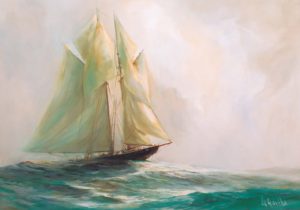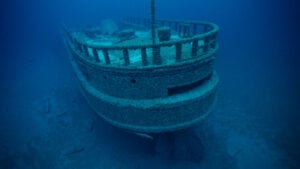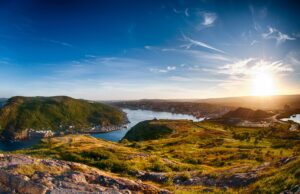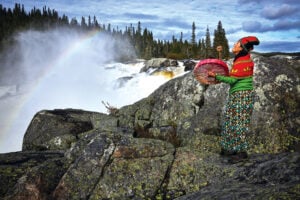
History
Bluenose: Behind the sails
The symbolism of the iconic Canadian fishing and racing schooner Bluenose may be as relevant today as it was 100 years ago when the ship first hit the water
- 3226 words
- 13 minutes
This article is over 5 years old and may contain outdated information.
History

Draken Harald Hårfagre—the world’s largest modern Viking ship—has arrived in St. Anthony, Newfoundland. The ship, which set sail from Haugesund, Norway at the end of April, is recreating the first ever transatlantic crossing and the Viking discovery of the New World over a thousand years ago.
It will have a few other Canadian stops including Quebec City and Toronto, before concluding its journey in New York at the end of September.
The crew—comprised of 32 volunteers selected from 4,000 applicants—might not be experiencing the same challenges as Leif Eriksson did, but the trip has been gruelling nonetheless. Their Facebook page mentions extremely cold and wet conditions, difficulty navigating around icebergs, and repairing broken equipment, all testaments to the historical parallels between the Draken’s journey and the Viking’s.
The ship is 35 meters long, eight metres wide, and has a mast that reaches 24 metres. There are 25 pairs of oars that the crew vigorously rows to reach top speeds of 14 knots. Its design was influenced by the Gokstad ship — a Viking ship found in a burial mound in Sadefjord, Norway in 1879—and the project was initiated by Norwegian entrepreneur Sigurd Ase.
In an interview with The Telegram, the Draken’s captain Björn Ahlander says the journey is a great adventure and a unique opportunity to recreate history, but will also be a rigorous test of strength and determination.
Are you passionate about Canadian geography?
You can support Canadian Geographic in 3 ways:

History
The symbolism of the iconic Canadian fishing and racing schooner Bluenose may be as relevant today as it was 100 years ago when the ship first hit the water

Exploration
Yvonne Drebert and Zach Melnick set out to make a documentary about invasive quagga mussels in the Great Lakes. Along the way, they found the wreck of what is likely the steamship Africa, last seen on a stormy October night in 1895.

Travel
Immerse yourself in Viking archaeology and Basque whaling history while taking in Newfoundland’s scenic coastline and incredible geology

Environment
In February 2021, the world was introduced to Mutehekau Shipu — also known as the Magpie River — when the people of Ekuanitshit, Que. and the regional municipality made a joint declaration granting the river legal personhood and rights. The declaration carries broad implications for the fight to protect nature across Canada and around the world.